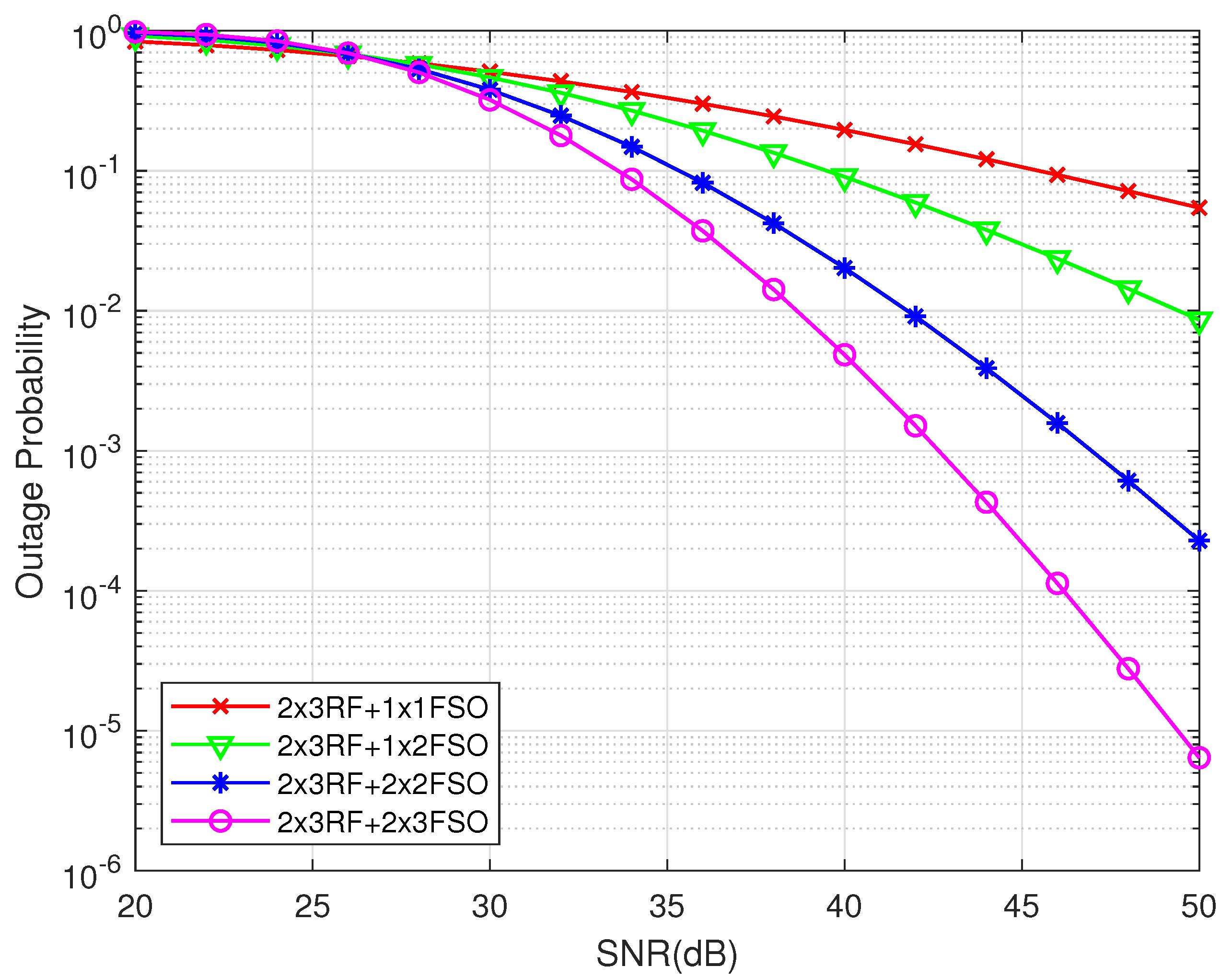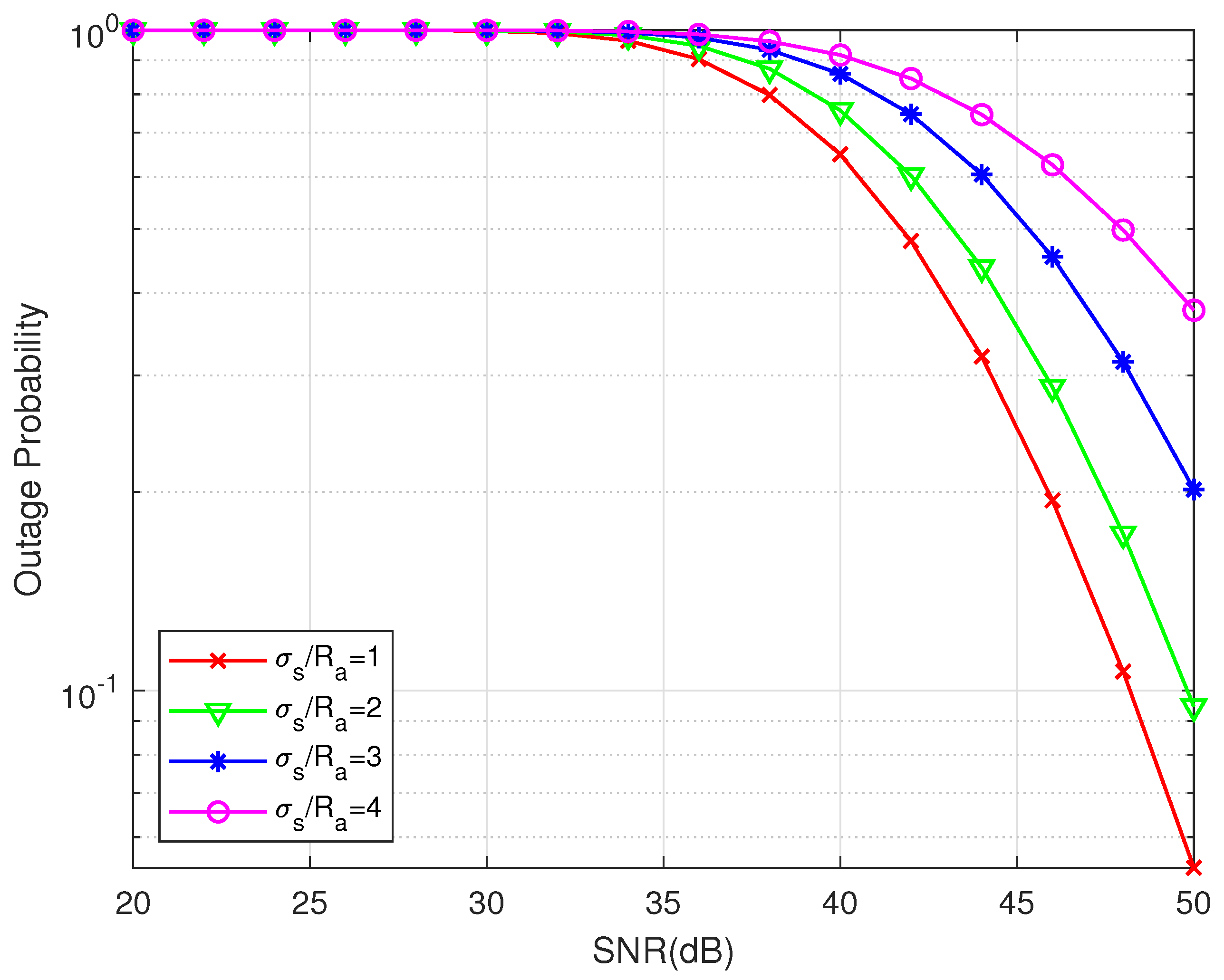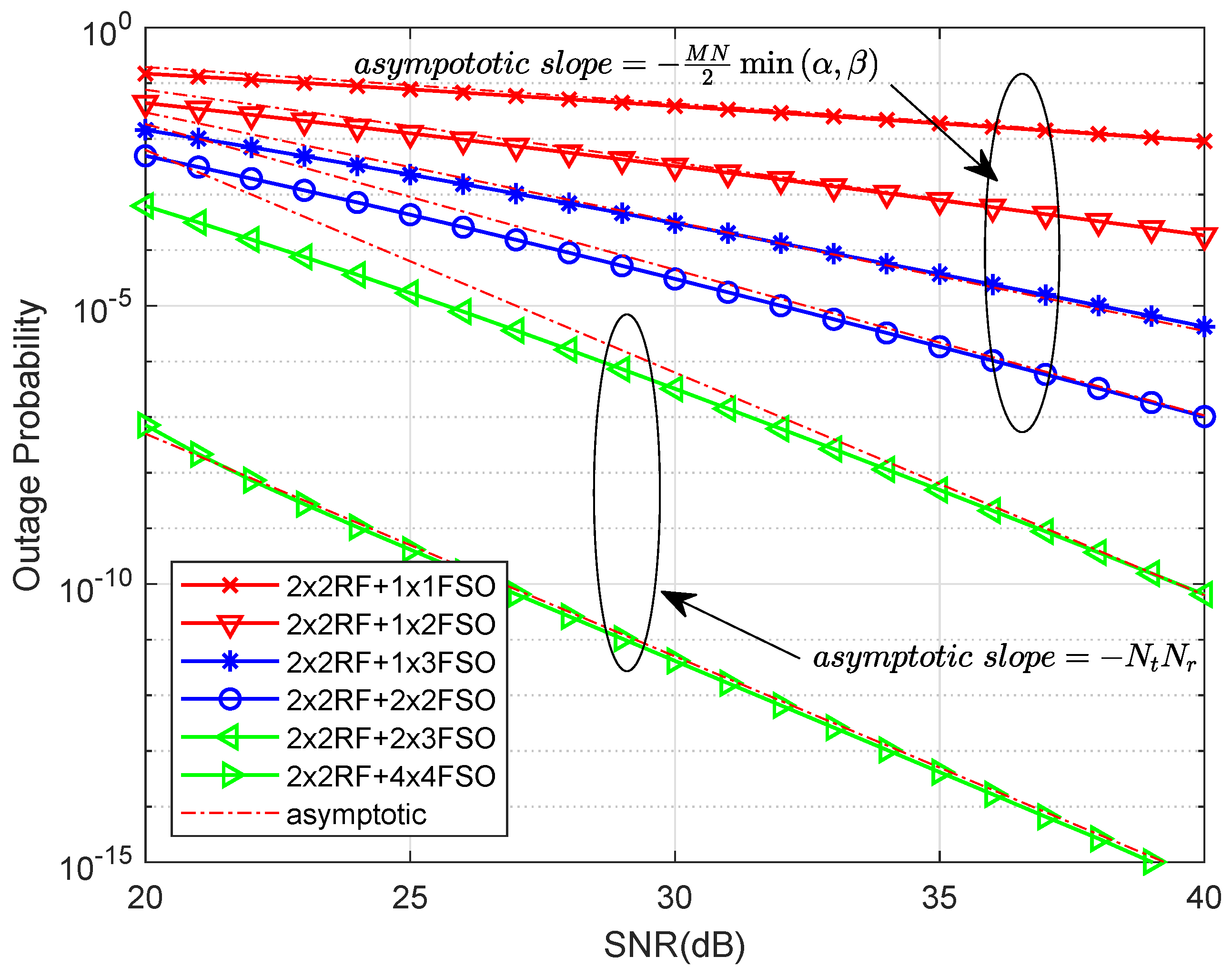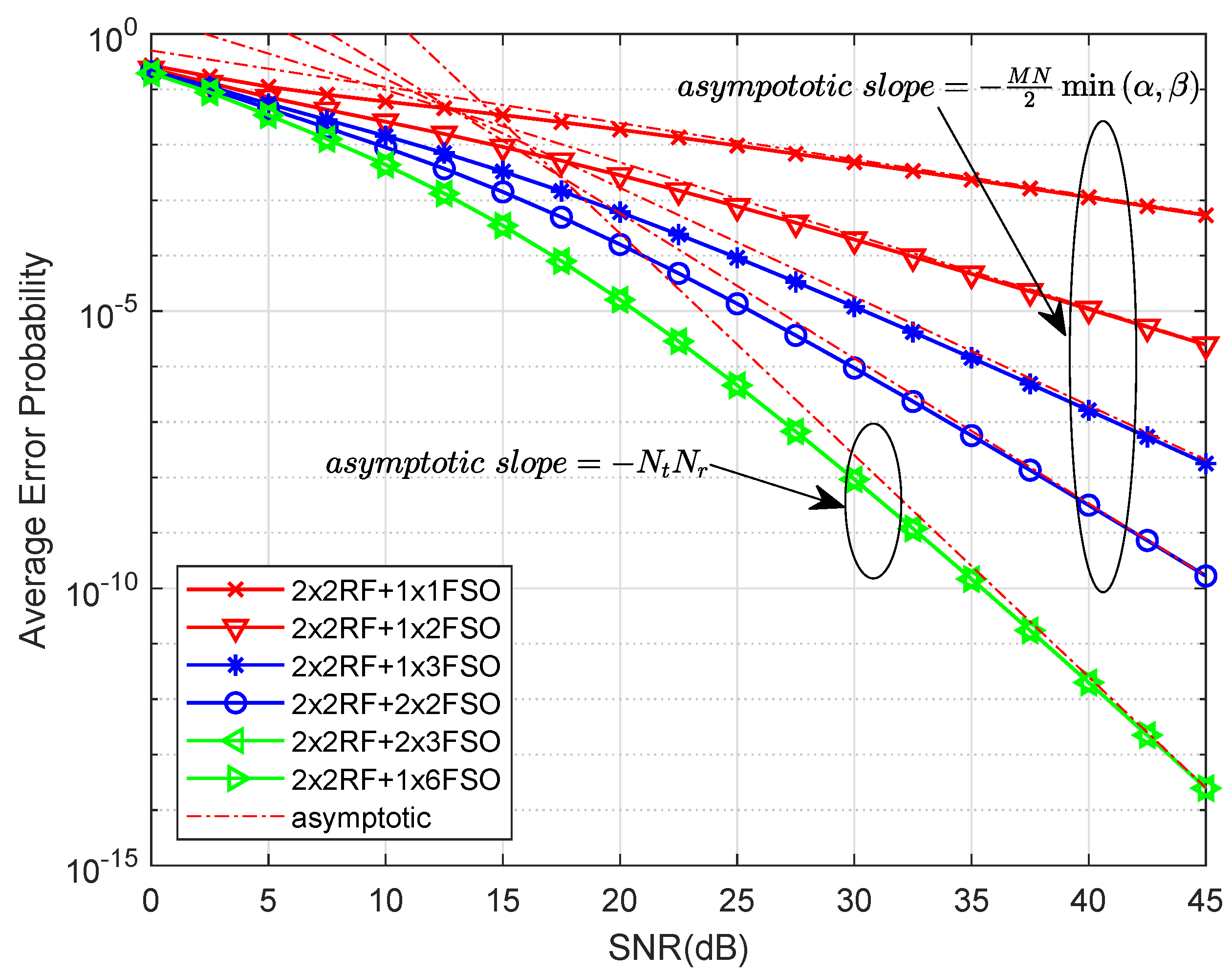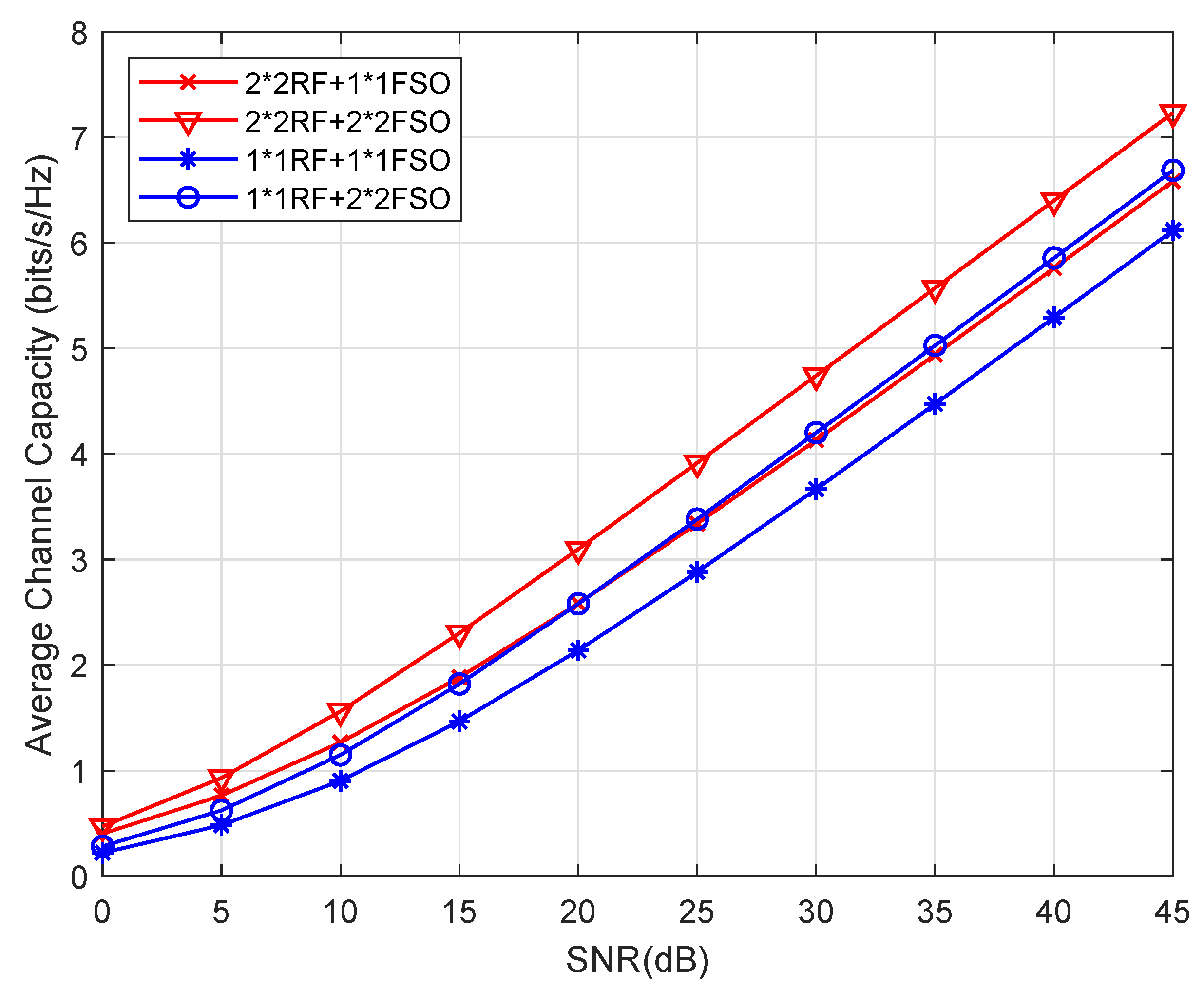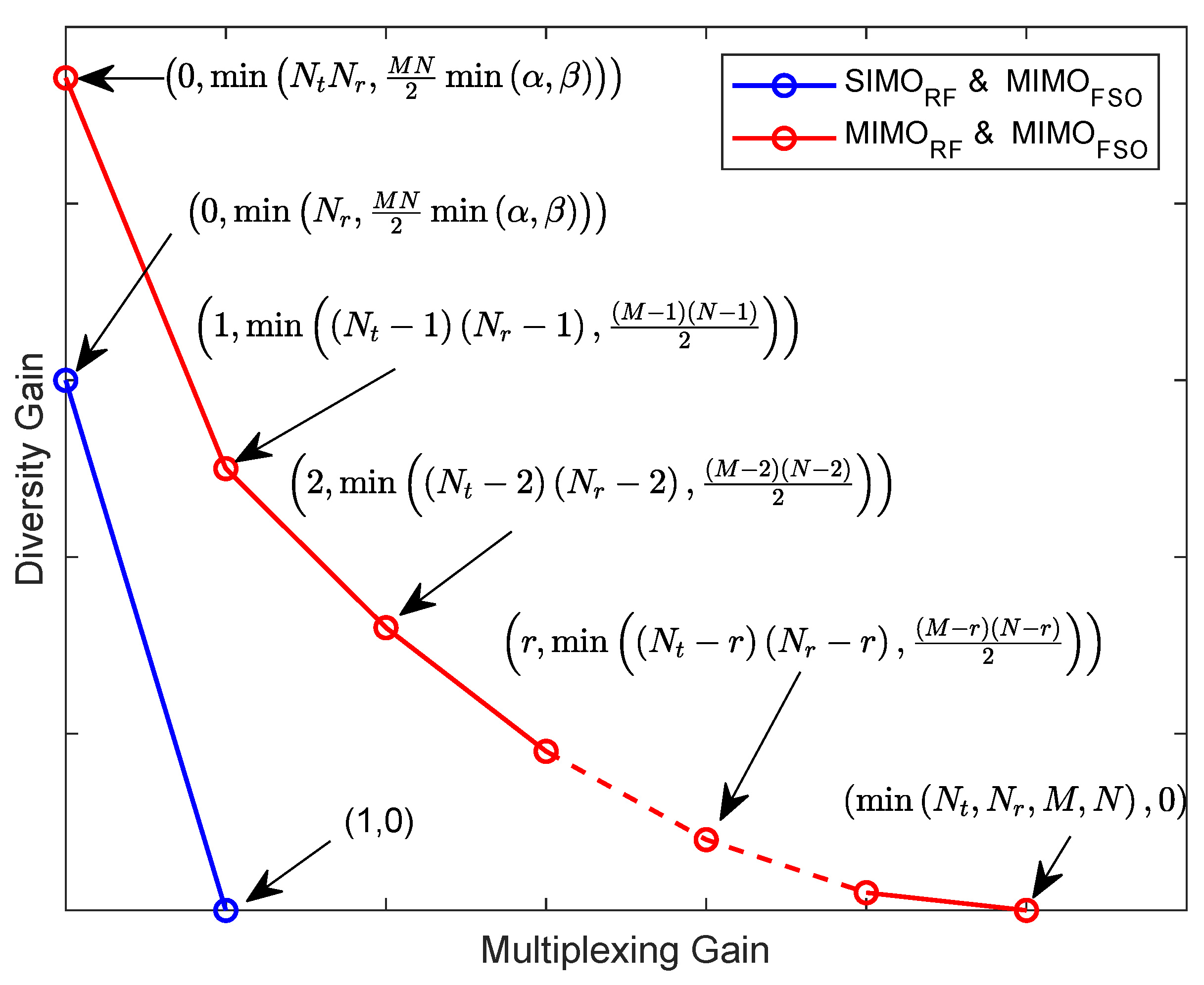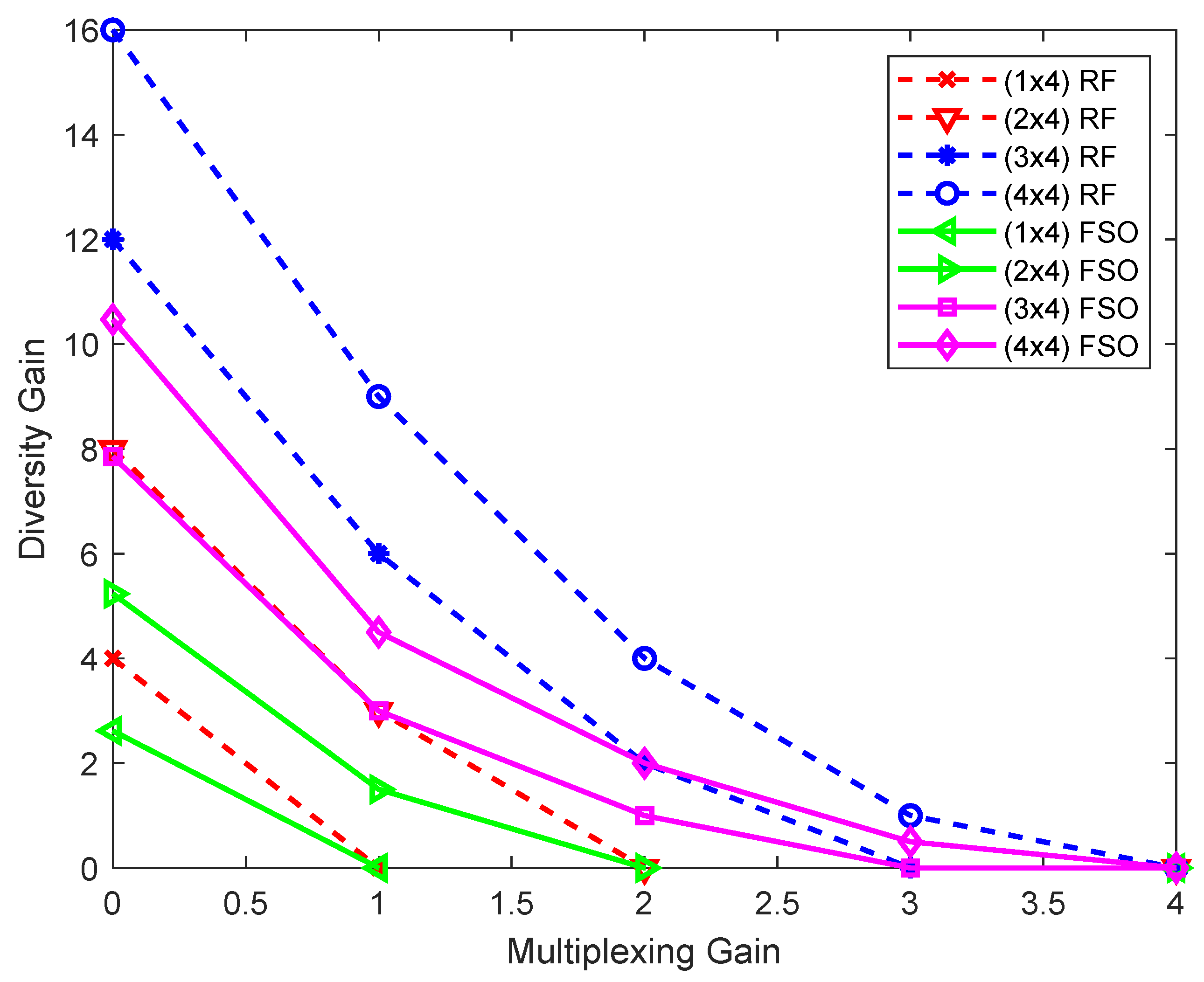1. Introduction
Dual–hop relay technology has gained enormous attention in the last decades because it not only broadens the coverage but also increases the capacity of the wireless communication networks [
1]. This technology splits the source to destination channel into two shorter links, which usually has an asymmetric fading distribution (called mixed fading channel) [
2]. In this case, it reduces the possibility of the entire communication system falling into deep fading, making the system more robust.
Unlike the traditional radio frequency (RF) relaying system, a mixed RF/free space optical (FSO) system combines the advantage of the FSO technique, such as low cost, free license, large bandwidth, high data rate, good security, etc [
3]. However, FSO techniques are sensitive to the atmospheric absorption and turbulence. In order to mitigate the impairment caused by atmospheric turbulence, the multiple input multiple output (MIMO) technique can be applied to the FSO link [
4]. The MIMO technique has been widely used in RF wireless communication, which is available to increase data rates and mitigate the disadvantages of fading [
5]. To the best of our knowledge, the majority of published literature focused on the mixed RF/FSO communication systems with a single optical antenna [
6]. Even though Reference [
7] investigated a mixed single input multiple output (SIMO) RF/MIMO FSO relay–assisted system, it still does not take into account that the RF link adopts the MIMO technique. In order to take full advantage of the MIMO technique, the performance of the full MIMO mixed RF/FSO communication systems still need further investigation and discussion.
Reference [
2] firstly analyzed and presented the performance of a dual-hop asymmetric RF/FSO relay system. Based on this framework, there are plenty of researches on mixed RF/FSO relay systems in different circumstances. Reference [
8] employed transmit diversity at the source and selection combining at the destination. The relay is equipped with a single RF receive antenna and one aperture. The authors used the cumulative distribution function (CDF)–based method to derive the outage probability, symbol error rate, and average capacity performance. However, compared to the MIMO relay system, when the same diversity gain is achieved, this system requires more antennas.
Reference [
9] investigated a decode–and–forward (DF) based asymmetric dual–hop mixed RF/FSO communication link. It was assumed that the source was moving and the source to relay link experienced time–selective Rayleigh fading. However, although the source to relay link applied the MIMO technique, the relay to destination link was still single input single output (SISO). Therefore, it was more susceptible to turbulence effects than the MIMO system. The end–to–end diversity order was still limited by the FSO link, which wastes the diversity gain provided by the MIMO RF link.
Reference [
7] analyzed multi–diversity combining and selection, which enhanced the performance of the relay assisted mixed SIMO RF/ MIMO FSO system. It only derived the outage probability (OP) of the proposed system. However, the bit error rate and average channel capacity of the system has not been given. This reference also did not consider the impact of the pointing error on the entire system, which has a great impact on the optical communication system.
Motivated by the practical application scenarios of the mixed RF/FSO systems. In this paper, we investigate the asymmetric dual–hop MIMO mixed RF/FSO DF relaying system. The model studied in this paper avoids the limitations of the model in the previous literature and provides better performance for the relay channel. This model has the characteristics of excellent error performance, high energy efficiency, and strong robustness, attracting attention as an effective solution for the large capacity data transmission demands of ”last mile” communication. This paper will also provide a direct theoretical basis for future large–capacity and high–speed communication systems.
This work is an extension of previous work [
10]. The biggest difference between this article and the Reference [
10] is that this article considers a more general full MIMO relay model, including the use of multi–antenna reception and transmission at the relay node instead of a single antenna relay as in Reference [
10]. This paper focuses on the impact of the diversity-multiplexing performance of the overall link when the number of RF link and FSO link antennas are different. Our analysis provides a generalized framework of a multi–antenna mixed relay system, so that the designer can have an intuitive understanding of the transmission rate and stability requirements of the entire system.
The rest of the paper is organized as follows:
Section 2 gives the model of RF and FSO channels, and we will derive the probability density functions (PDF) and CDF of each link. In
Section 3,
Section 4 and
Section 5, we will derive the closed form end–to–end outage probability, average bit error probability and average ergodic capacity of the considered system, respectively. Further, we will analyze the diversity order and diversity–multiplexing tradeoff of the proposed system in
Section 6 and
Section 7.
Section 8 conducts numerical simulations and analyses. Finally,
Section 9 presents the conclusions.
2. System and Channel Model
The block diagram of the system is shown in
Figure 1. The channel from source to relay link is Rayleigh distributed and the FSO link is characterized by Gamma–Gamma (
) turbulence. The system uses DF relay to convert electrical signals to optical signals.
For the RF link, it consists of
transmitting antennas and
antennas for reception. Binary phase shift keying (BPSK) modulation is adopted in the RF link. The received signal vector can be expressed as
. where
is the channel coefficients matrix, which consists of
statistically independent elements.
is the noise vector, which is assumed to be Additive White Gaussian Noise (AWGN). This link is assumed to be characterized by Rayleigh fading.
is the transmitted signal vector.
c is the transmitted symbol and
is the transmit weighting vector. The source to relay MIMO RF link adopts the maximal ratio transmission (MRT) [
11]. At the relay, the corresponding CDF of
is
We adopt a DF relaying based system. The relay decodes the received RF signal and modulates the signal into an optical signal. For the FSO link, we assumed that the relay is equipped M photo aperture transmitters and the destination is equipped with N photodetectors. The transmitter adopts repetition coding (RC), and an equal gain combining (EGC) technique is employed at the receiver. The relay node uses the subcarrier intensity modulation (SIM) technique for converting the input signal into the optical signal [
12]. A DC bias is added to the optical signal by the laser diode to avoid the negative valued signal. At the receiver, the DC bias is filtered out. We assume that the distance of photodetectors is greater than the coherence distance to ensure that the received signals are uncorrelated.
First, we consider the case where the pointing error is not negligible. The received signal at the
th antenna can be expressed as:
where
denotes the optical–to–electrical conversion efficiency,
x denotes the transmitted signal and
is the Additive White Gaussian Noise (AWGN) with zero mean and variance
. Let
, using the equal gain combining (EGC) technique, the total received SNR can be expressed as:
where, the average SNR is defined as
, and
.
For the pointing errors, the independent identical Gaussian distributions for the elevation and the horizontal displacement (sway) are considered. The PDF of the pointing error existing on the i–th transmitting antenna received by the j–th receiving antenna is given by:
where
is the ratio between the equivalent beam radius
at the receiver and the pointing error displacement standard deviation
(jitter) at the receiver.
denotes the fraction of the collected power at
,
,
is the beam waist,
denotes the aperture radius of the receiver.
represents the equivalent beam waist.
Reference [
13] proposed a new method to approximate the distribution for the sum of L
fading with Rayleigh pointing error random variables, the PDF is shown as following:
where
is the instantaneous SNR of the FSO link and
is the average SNR of the FSO link.
,
denotes the parameter related to misalignment. The parameters
and
are given by [
14]
where
is the Rytov variance, which is given by
.
is the refractive index.
is adjustment parameter, which is given by
( −0.127−0.95
)/
.
is the Gamma function,
is Meijer’s G-function, and,
. The coefficient
,
is the order of the modified Bessel function of the second kind.
is Lah numbers [
15] and it is defined as
, for n, i > 0. The correcting factor
F is defined as
.
According to the distribution theorem of the random variable function, the PDF of the
can be expressed as:
Then, substitute Equation (
7) into Equation (
5), the following expression can be obtained:
Using ([
16] [Equation (07.34.21.0084.01)]), we can get:
where symbol
denotes the L times repetition of a given tuple.
Further, we use ([
16] [Equation (07.34.17.0011.01)]) to simplify the expression. Finally, we get CDF of
as the following:
Due to the complicated form of the above formulas, in order to analyze the main determinants of the approximate performance of the entire system under the high SNR region, we have considered the case where the pointing error can be neglected in the following analysis.
When the pointing error can be neglected, that is to say
, we assume the link of MIMO FSO is characterized by
turbulence. Considering the complexity of the calculation, we simplify the system model. We currently do not consider the impact of misalignment on the system. For MN statistically independent and identically distributed
random variables, the probability density function (PDF) is as follows [
17]
We can derive the CDF of the
as
where
.
6. Asymptotic Performance Analysis
In order to analyze the diversity order of the considered asymmetric dual–hop MIMO mixed RF/FSO DF relaying system, we need to further study the asymptotic behavior when .
For the RF link, the exponent function can be expanded into series form. We can rewrite the CDF of
We neglect the higher order terms. The asymptotic outage probability of the RF link can be derived as
For the FSO link, the series representation of the Meijer’s G function is given by ([
16] [Equation (07.34.06.0006.01)]) into
Considering that
, the asymptotic outage probability of the FSO link can be obtained as follows
The asymptotic approximation of the end–to–end OP is given by
Therefore, the diversity gain of the considered asymmetric dual–hop MIMO mixed RF/FSO DF relaying system .
8. Numerical Simulation and Discussion
In this section, numerical simulation of the considered asymmetric dual–hop MIMO mixed RF/FSO DF single relaying system’s OP, BER, and capacity are presented, respectively. For the MIMO RF link, the system transmitter and receiver’s number are , . For the MIMO FSO link, laser wavelength , transmitter and receiver’s number , , outer scale , inner scale . For the number of series expansion terms considering the pointing error, we assume J = 20 is accurate enough for our simulation channel conditions.
Figure 2 illustrates the outage probability of the MIMO mixed RF/FSO system with pointing error in the case of different optical antennas. Where
,
.
= 10 dB. It can be seen from the figure that even in the presence of pointing errors, the outage probability of the system decreases as the number of optical antennas increases. For example, the outage probability of
scheme yield
when the SNR is 40 dB; while
only yields 0.1957.
Figure 3 presents the outage probability of the MIMO mixed RF/FSO system under the different pointing error influence. The simulation parameters are as follows
,
,
= 10 dB. It can be observed that the outage probability is greatly affected by the pointing error. The severity degree of the pointing errors increases as the value of
increases, and the outage probability also increases. For example, the outage probability of the system achieves
when the average SNR is 50 dB and
, while the system achieves 0.3767 when
.
Figure 4 is a plot of outage probability of the considered MIMO mixed RF/FSO system without pointing error when
= 5 dB. We assume that the average SNRs of each link are the same. As can be seen, the system’s diversity order mainly depends on the minimum diversity order of each link. For example, when
, the slope of the OP curve is
, which means the diversity order depends on the FSO link. On the other hand, when
, the slope of the OP curve is
, which means the diversity order depends on the RF link.
Figure 5 illustrates the bit error rate (BER) performance of the considered MIMO mixed RF/FSO system without pointing error vs. average SNR per hop. As seen, the system performance improves when the number of antennas is increased, since this also increases the performance against fading and reduces the decoding error at the relay. We can also see the same characteristics as the OP performance and the end–to–end diversity gain is determined by the minimum diversity gain of each hop. Therefore, in different scenarios, we can flexibly combine the number of source, relay, and receiver antennas to obtain the same diversity gain; for example, when the complexity of the relay is limited, we can reduce the number of the relay’s antennas and increase the number of antennas at the source and receiver to obtain the same diversity gain.
Figure 6 presents a comparison of the average ergodic capacity of different schemes of MIMO mixed RF/FSO systems without pointing error. It can be seen that the MIMO system can significantly increase the system’s end–to–end channel capacity compared with the SISO system. For instance, the ergodic capacity of the system of
is 6.12 bits/s/Hz at the SNR of 45dB. While the ergodic capacity of the system of
is increased to 7.23 bits/s/Hz.
Figure 7 shows the diversity–multiplexing tradeoff of the considered MIMO mixed RF/FSO system and SIMO RF/MIMO FSO relay system. Compared with the SIMO RF/MIMO FSO relay system, the MIMO system considered in this paper has obvious advantages in diversity gain and multiplexing gain, as shown in the figure. In particular, the end–to–end maximal diversity gain of the system is
, and the maximal multiplexing gain is
. We can flexibly allocate diversity or multiplexing gain through different coding methods under different fading conditions. For example, we can use Vertical Bell Labs Layered Space–Time (V–BLAST) encoding to obtain a higher transmission code rate when the channel condition is good. On the other hand, we can use RC to combat channel fading when the channel condition is poor.
Figure 8 presents diversity–multiplexing tradeoff (DMT) curves of different number MIMO antennas configurations of RF links and FSO links, respectively. From the figure we can find that DMT curves of FSO links are always lower than the curves of RF links under the same configuration. The reason is that the channel of the FSO link using the IM/DD method only provides one degree of freedom. While the RF channel provides complex–valued channel coefficients, which has two degrees of freedom, this greatly affects the diversity gain. Further, we find that there is an intersection point between a (3 × 4) RF curve and (4 × 4) FSO curve, which means that the end–to–end maximal diversity gain is determined by the FSO link and end–to–end maximal multiplexing gain is determined by the RF link, respectively. It is obvious that as the number of antennas increases, both maximal diversity gain and maximal multiplexing gain increases.
Figure 9 presents the DMT of the MIMO mixed RF/FSO system with an intersection under different conditions. Similar to
Figure 8, we consider the universal case of intersection under the system we considered. Since the DMT curves of RF and FSO are both decreasing, consider the following two situations, (1)
and (2)
, then the two curves have at least one intersection as shown in
Figure 9a,b respectively.
Figure 9a shows that maximal diversity gain depends on the RF link under situation (1). While maximal diversity gain depends on the FSO link under situation (2), as shown in
Figure 9b. While the maximal multiplexing gain dependence is opposite.

